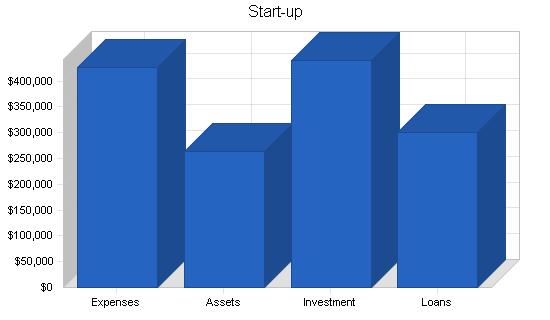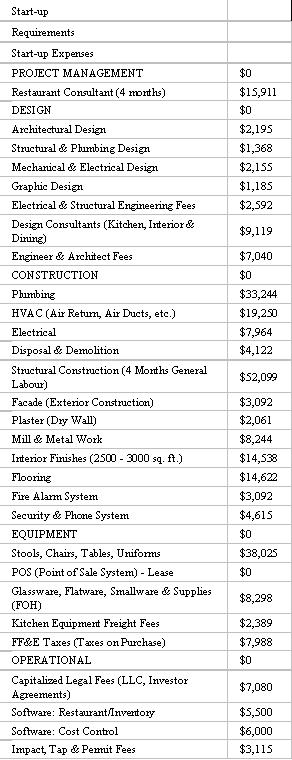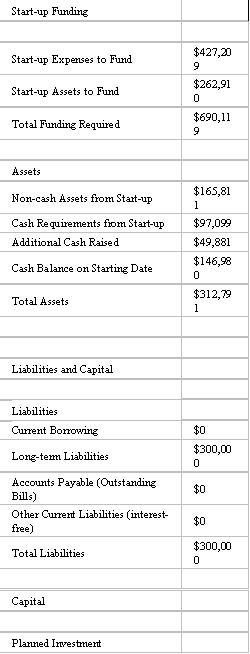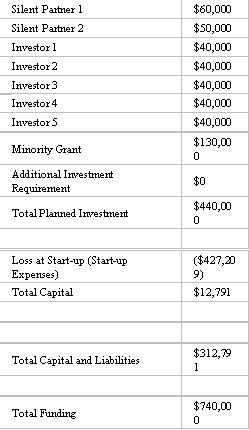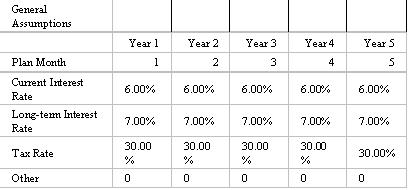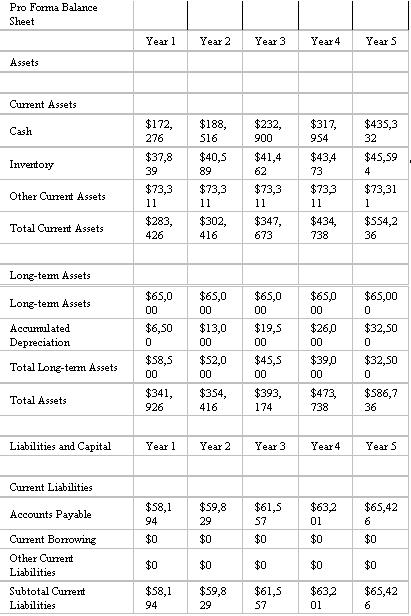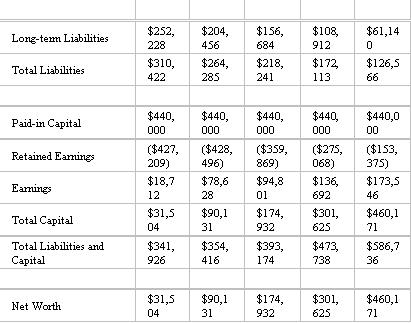Executive Summary
Our initial statement to Investors and Financial Lenders is a candid disclosure of the Green Papaya Restaurant business proposal - our goal is to aim at realistic business expectations, and eliminate any questions about the profitability of this business venture. People in business like to cover all the gray areas of a business venture such as this, but we would like to keep an open mind and reflect on the positive and lessen the risk. We, as business owners, have taken in account all the necessities to make the growth of this business more successful. Our intent is to expand our business, financial, and marketing plan that not only serves our need for capital financing, but is utilized as our daily business roadmap. We have taken all precautions to validate our business and financial models, focusing on realistic projections. We have accomplished this as follows:
1. Our financial model is derived from an ongoing business that is doing well. We have based costs on our already thriving business and only intend on making it more successful. We intend on doing this by adding more ethnic drinks and entrée items to our menu. We also, intend on expanding on catering.
2. Our business concept was derived from detailed Market Analyses. We have analyzed the business market, thoroughly, in this area. We are answering to our consumer’s ‘wants’. We want to cater to the consumer and through thorough analysis we have come to the conclusions we are presenting to you.
3. A filtered financial analysis that ensures substantial capitalization. A contingency filter is included in the additional cost to ensure the business in not under financed, as well as giving the business substantial funding to sustain it in the first six months of additions. Our industry experience confirms a longer ramp-up stage for restaurants over other retail/service businesses. A common mistake for new entrepreneurs, but fully addressed in this business plan.
4. A solid Risk Mitigation Plan. We have evaluated traditional and non-traditional risks associated with Restaurant failure and accounted for them directly in the business plan. Instead of dismissing the risks, we have identified valid mitigation strategies for each.
5. Deep Management Experience.
The total capital requirement to launch expansion of the Green Papaya is $740,000, of which $643,000 is allocated to start-up capital, and $97,000 as business operations cash reserve. This Plan is being submitted in order to secure a Business loan for $430,000. The loan will be used towards Equipment purchase, Design, Construction, and Operational Start-Up expenses. Owners, Mr. Alex Hunte and Mr. Peter Smith are investing $110,000 in personal capital. Private Investors, who will be part owners with a non-managerial interest in the business, will contribute the remaining $200,000.
As owners, our commitment is to take personal accountability for all financial debt. We have taken the necessary precautions to ensure the business is fully capitalized, and have addressed all financial shortfalls to ensure a successful business start-up. Under a realistic scenario, the company should have over $84,000 in cash balance the third year. Even with the worst-case sales scenario, we reach a Net Worth break even at the end of Year 5. On a linear projection, the entire financial debt will be retired by Year 7.
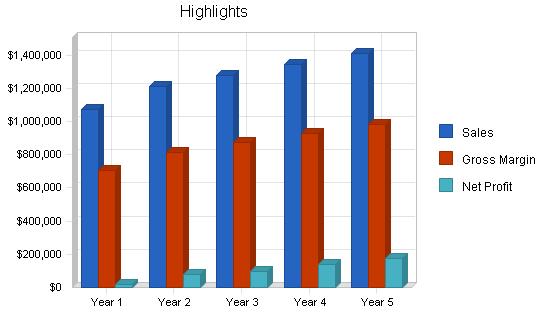
- Green Papaya has been an inspiring restaurant, combining a soothing atmosphere with excellent and interesting food. The mission is to have not only a great food selection, but also efficient and superior service - customer satisfaction is our objective. Green Papaya has been the restaurant of choice for customers such as families to the dating couple.
- Employee welfare, participation, and training are equally important to our success. Everyone is treated fairly and with the utmost respect. Our employees feel they are a part of the success of the Green Papaya.
- Our concept combines variety and ambiance our superior staff has created a sense of 'place' in order to reach our goal of overall value in the dining experience. We offer fair profits for the owners and investors, and a rewarding place to work for the employees.
Mission
- Unique, Innovative & Contemporary: The creation of our unique fine dining atmosphere differentiates us from the competition. The restaurant stands out from the other restaurants in the area because of the unique design and decor. We will offer a fine dining experience in a soothing atmosphere.
- Product quality: great food, great service and atmosphere.
- Menu: The menu will appeal to clientele, due to, the more varying items added.
- Employee Retention Focus: Employee retention and development programs are a primary focus and success platform for this business. Through these programs, we are able to have a professional staff knowledgeable in the cuisines that we offer. We have budgeted for a stock option program for Chef and Management positions to subsidize a lower salary base. This lowers our immediate overhead and attracts quality staff.
- Cost Control Focus: We have controlled cost at all times, without exception.
Cost Control has been an integrated function of the restaurant from the onset.
Cost control is about managing the numbers - interpreting and comparing the
numbers that impact the bottom line. We determined this cost before we even opened
our doors. Our focus is based on reduction of cost of goods sold to meet our profit
margin goals by managing the following crucial elements of cost:
- Purchasing
- Receiving
- Storage
- Issuing Inventory
- Rough Preparation
- Service Preparation
- Portioning
- Order Taking
- Cash Receipts
- Bank Deposits and Accounts Payable
- Keeping food costs at less than 35% of revenue.
- Improving our Gross Margin from 65.41% in Year 1 to 67.10 in Year 2. We managed to hit a target of 70.73% in Year 3.
- We have kept employee labor cost between 37-39% of total sales.
- We want to remain a small and authentic restaurant.
- Averaging sales between $1,200,000 - 1,500,000 per year.
- We want to promote and expand the Green Papaya restaurant concept as a unique restaurant.
- Expanding our marketing and advertising in Fort Smith and in the neighboring suburbs to increase our customer base.
- Achieving a profitable investment return for investors within Years 2 - 6.
- Restaurant Location
Southside Fort Smith is the location of Green Papaya. We chose this location lack of
oriental restaurants in the area, and it had already been set up for a restaurant.
The market has been carefully selected and tested for the necessary
demographics and retail traffic necessary to meet the goals laid down for
profitability. The busy south side location and future developments occurring
on this side of town is sure to draw profits suitable for this venture
- Operating Criteria:
The restaurant is located on the Southside of Fort Smith.
The restaurant services lunch and dinner. The restaurant operates during
peak service time to take advantage of street traffic, family time
dining, and/or couples time. Service will be available during
the following hours:
Monday - Friday: 10am to 9pm
Saturday - Sundays: 11am to 9pm - Menu Variety: There is a large amount of ethnic restaurants in the
Fort Smith area. The proliferation of international cookbooks, food
magazines, TV cooking shows and imported goods offers ample evidence
that America, as a whole, is currently on an international tasting spree.
Again, variety is the underlying element for this establishment.
- The Dining Experience: Customer satisfaction with food and service
has been and continues to be of utmost importance, but our findings indicate
that the décor, lighting, and other options to improve the dining experience
are also factors in customer decisions. Green Papaya has taken all these
factors in consideration for the design of this restaurant.
- Reasonable Prices: This was no surprise given the economic tide.
Although the restaurant industry as a whole has seen growth in 2002/2003,
customers are demanding value for their dining dollar. Green Papaya menu
is priced at a mid-tier level, with no entrée over $13. In addition we have
an extended Appetizer selection priced between $2 - $8, allowing
budget dining in a full-service restaurant.
- The Business Person
- Fort Smith/surrounding area Couples
- The Returning Customer
- Families
- Tourists
- The Business Person: They work hard all day and often stay overnight in a strange city. They need a competent establishment that helps impress clients and prospects. Afterward, they want to relax and use the money they are making (or are expensed by their company). They spend the most on drinks, food and tips. Green Papaya’s unique and comfortable atmosphere is perfect for sophisticated business people, whether they live in and around Fort Smith or are here for work.
- Fort Smith/Surrounding area Couples: The restaurant has an intimate, romantic, enticing atmosphere that suggests "date." Green Papaya is the best date location in town. These young Midtown couples are generally very successful working professionals. In most cases they are budgeting to eat out on a regular basis, as they don't have the time to prepare food nightly.
- The Destination Customer: Fort Smith is a much 'sectioned' city, and consumers often look only in their own neighborhoods for restaurant options. Green Papaya has broken these habits, using marketing to draw customers from outside the main city limits. Green Papaya will be a destination restaurant. Our Destination Clients tend to be new suburbanites that miss the excitement of the inner city. They have disposable income, and will spend quite a bit on such outings. Green Papaya is especially appealing to married suburban couples indulging themselves with a "date night", away from the kids.
- Families: We attract them with our soothing atmosphere. Our international menu, fast friendly service, and they don’t have to clean after themselves. With both members of the family having to work it is idea to take the family out to dinner.
- Tourists: Fort Smith attracts many travelers, whether it be business or vacation. Green Papaya is a destination dining locale, with its attractive atmosphere, international menu, and fast friendly service. A large percentage of the tourist population is looking for something quick or a relaxing atmosphere.
- The owners' thorough understandings of running a restaurant
- An extraordinary contemporary restaurant design
- International menu with featured menu
- Unique, 3-Tiered spatial layout
- Chef Co-op program to allow new entrants, trainee and featured chef
- Chef/Management Stock Incentive Program.
- Inner and Outer City Marketing campaign (i.e. "Come to Town" promotions)
- Employee Training, Incentive and Retention program
- China Jade(Direct Competitor): We were able to draw some conclusions from this analysis that helped defined the concept and positioning for Green Papaya: 1) Keep the menu pricing modest but offer superior food quality and presentation. We plan to keep the menu prices under $10; 2) The location is suitable. China Jade is in this area it has done well, but it is more a buffet. 3) The customer base in this segment of Fort Smith is taking to the Vietnamese cuisine.
- Lin’s Garden (Direct Competitor): This restaurant is a main competitor for Green Papaya, a casual dining restaurant that has evolved to be a great success story for central Fort Smith. This restaurant served to validate 1) the concept of variety for its customers; 2) the customers need for dinning; 3) reasonable pricing on all you can eat; 4) the appeal of enchanted atmosphere.
- La Huertas (Indirect Competitor): This restaurant has grown in popularity over the years, and has gained popularity as a destination restaurant that can cater to business professionals as well as the local residents. The menu is somewhat formal for this market segment, but the bar attracts a good crowd. La Huertas is more of a formal dining restaurant and meets a certain need within the community, but I don't see it as a direct competitor of Green Papaya. I do feel that it has some very special elements that have helped it succeed over the past 10 years, which Green Papaya can benefit from.
- (#1 Restaurant Comparison): Although Pho Vietnamese is outside of Green Papaya restaurant district and is considered a direct competitor, it was beneficial to analyze the most profitable restaurant in Fort Smith to understand what contributes to their success. Pho Vietnamese offers several key elements that would also benefit Green Papaya: 1) Customer Satisfaction through moderate pricing and high-quality food; 2) Location selection to benefit from core customer demographics, situated in a busy/popular area for both business and residential traffic; 3) Exceptional Service, from Hosting, to Wait, and Bus; and 4) Menu Variety, offering a broad array of menu items.
- Take out a suitable size add in yellow pages.
- Scheduling adequate frequency of radio ads to advertise.
- Redirecting customers to our website for tourist and business people.
- Maximizing ads in the local newspaper.
- Important Assumptions
- Risk Analysis & Mitigation Plan
- Sales Forecast (5.3.1, above)
- Break Even Analysis
- Profit and Loss Statement
- Cash Flow Statement
- Balance Sheet
- Year 2: 6%
- Year 3: 5%
- Year 4: 4%
- Year 5: 4%
- Monday: 55%
- Tuesday: 60%
- Wednesday: 75%
- Thursday: 95%
- Friday: 90%
- Saturday: 100%
- June: 70%
- October: 100%
- February: 95%
- July: 75%
- November: 95%
- March: 85%
- August: 80%
- December: 95%
- April: 90%
- September: 85%
- January: 85%
- May: 90%
- Year 1: Lunch = 70%, Dinner = 88%
- Year 2: Lunch = 82%, Dinner = 100% (implied wait period)
- Year 3: Lunch = 87%, Dinner = 100% (implied wait period)
- Month 1: 32% / 51%
- Month 4: 64% / 75%
- Month 2: 41% / 58%
- Month 5: 80% / 90%
- Month 3: 52% / 66%
- Month 6: 90% / 92%
- Year 1: Lunch = 1.0, Dinner = 1.0
- Year 2: Lunch = 1.0, Dinner = 1.0
- Year 3: Lunch = 1.0, Dinner = 1.25
- How do we allow an adequate startup period and capital to launch the concept and grow our customer base in a competitive sector? Our financial plan is budgeted to support the Worst-Case business scenario. We addressed the financial risk as follows:
- We looked at our monthly break-even.
- We calculated worst-case monthly financial shortfall based on the ramp-up sales percentages outlined in our financial assumptions.
- We budgeted operational shortfall in an operational contingency budget that we will utilize if the need arises.
- The current Economic slowdown and recovery state was a key consideration in our restaurant concept. How do we manage a successful restaurant in current market conditions? Our original effort was to open a restaurant twice the proposed size. As we are in the midst of an economic recovery, we have scaled back the size to reduce business overhead, startup requirements, and business operating capital. Another mitigation has been our overall Restaurant concept. We have the menu priced at a mid-tier level with no entrée over $20. In addition, we have an extended Appetizer selection priced between $3.50 - $9.50, allowing budget dining in a distinguished restaurant.
- How do we confirm that our Funding Requirement is sufficient? We have leveraged our membership with the National Restaurant Association to look at industry averages for this market segment for Restaurant startup and Operations. Additionally, we included a contingency buffer in the financial estimates to account for any potential cost variance. We have worked with our Restaurant Consulting firm to validate our cost estimates to their industry knowledge.
- How do we know we have selected the right location for this concept? Again we will draw on the Consulting group that has the expertise in site selection and lease negotiation. In all, there are no guarantees with location, but we took a very objective approach with our concept. Instead of going in with a predefined business concept, we let the Market Analysis define the need. Site selection was based on space, visibility, and functionality.
- What if there is an additional need for Business Capital after the Restaurant has exhausted its 6-month buffer? Our intent is to be a self-sufficient business far in advance of the 6-month probation period. But as we are considering all contingencies, we have looked at this risk. We have accounted for an operational contingency budget that will be used to supplement any slow periods. Our next step would be to approach our private investors for capital by extending their return on investment. We would also look to the partners' capital reserves as another source of funds.
- Expansion (Option 1): Our overall goal to maintain Green Papaya as a unique and eclectic concept. Based on projections, the business has captured market share by the end of the first year. In addition Year 2 brings an increased sales and profit margin to sustain the addition of a full-time General Manager. By second quarter of Year 2, the owners will look to launch a second restaurant concept. This is not a chain, but another unique restaurant concept with strong growth potential. Expansion will be considered with our financial backers and Investor partners.
- Expansion (Option 2): Throughout our business plan we have stayed focus that Green Papaya would be successful as a larger venue, with greater sales capacity and revenue potential. Our objective with the site selection and lease negotiation is to have the opportunity to expand the restaurant as a logical growth and profit plan.
- Private Sale: We are in the business of making money. At the close of Year 3, we see Green Papaya as meeting 80.4% of its optimum sales potential with the current seating and space allocation. At this stage the business debt is reduced, profit margins are increasing, and Green Papaya has established market share. We will look at the private sale of the majority interest via A) Leveraged Buyout, or B) A larger Restaurant consortium. In both cases, our interest is in delivering healthy profits to our Investors and Financial backers. Sales and profit margins will be based on the restaurant valuation in Year 3.
- Financial Solvency: The financial projections indicate that exit will be achievable over 3 years for the operating capital line of credit. Under a realistic scenario the Company should have over $70,000 in cash in the bank after income taxes the second year. The entire financial debt would be retired by Year 7.
- Catering
- Advertisement(TV, Radio, Flyers)
- More Appealing Building
- New Menu Items
- Online Ordering
Keys to Success
Due to intense competition, restaurateurs must look for ways to differentiate their business to achieve and maintain a competitive advantage. Fort Smith has many ethnic restaurants, but we feel that with our soothing atmosphere and easy access we have proved our venture worthy.
Objectives
Green Papaya Restaurant’s objectives for the first three years we have been in operation:Company Summary
Our Design
Green Papaya has thrived in this business, due to, family dining or the dating couple. We have catered to both needs. We plan to stay small and quaint(appox. 60 customers), while catering to our customers ‘wants’.
The Menu
Green Papaya has focused on servicing Fort Smith’s growing demand for an ethnic eating experience. Green Papaya offers Vietnamese cuisine on the menu. The demographics show that in a location that is growing in this culture and households where both adults are working.
The Management
Our management team has over years combined experience in food, restaurantLocation & Operations
Services
Green Papaya Restaurant features Vietnamese dishes, authentic cuisines, and superior service. Our food will be of the finest quality and prepared with exotic flare. Customer satisfaction is the driving force behind our success. We will add to our menu as suites to customer ‘wants’. Portions are modestly sized, garnished with stunning presentation. The kitchen staff has extensive knowledge in the preparation of these cuisines. Their extensive knowledge gives the food its authentic taste. The restaurant staff offers the finest service and offer customers an extraordinary dining experience.Market Analysis Summary
Instead of building a business around preconceived notions, we conducted market research and built a concept around our consumers. Our market analysis identified the following key drivers as areas of opportunity to service Fort Smith’s restaurant customers:
Market Segmentation
Green Papaya Restaurant intends to keep catering to the customer’s ‘wants’. We like to make everyone feel welcomed. We have defined the following groups as targeted segments that contribute to our growth projections:These particular market segments range in age, have disposable income, and are seeking trendy and comfortable restaurant options. These are the types of people who frequent other restaurants in the area. They are likely to spend more on experiences they perceive as unique and authentic. They are also the most open to trying something new, food wise, and will embrace our international cuisine.


Target Market Segment Strategy
Service Business Analysis
Restaurants make money by taking inexpensive ingredients, combining them in creative ways, cooking them properly, and selling them at a much higher price. Any ingredients wasted in the kitchen are money thrown out. Any time wasted in seating customers, taking orders or preparing food is money walking away. While some entrepreneurs think that success is as simple as a good location and a trendy concept, we know the truth: To succeed in the restaurant industry, you need an understanding of the risks and financial conditions, the ability to handle enormous pressure, and the organizational skills to bring off what is essentially a giant catered party, two to three times a day.Competition and Buying Patterns
We know the restaurant business is competitive. We offer authentic food at a reasonable price, and we offer the soothing atmosphere, where a person can relax. We take care of all the needs that the customer may have when entering a restaurant.Strategy and Implementation Summary
Our strategy is simple. We intend to succeed by giving people a combination of excellent and interesting food in an environment that appeals to a wide and varied group of successful adults. We will focus on establishing a strong identity in our community with a grand opening. Our main focus in marketing thereafter will be to increase customer awareness in the surrounding communities. We will direct all of our tactics and programs toward the goal of explaining who we are and what we do. We will keep our standards high and execute the concept flawlessly, so that word-of-mouth will be our main marketing force. We will create an appealing and entertaining environment with unbeatable quality at an exceptional price. As an exciting and eclectic restaurant, we will be the talk of the town. Therefore, the execution of our concept is the most critical element of our plan. All menu items are moderately priced for the area. While we are not striving to be the lowest-priced restaurant, we are aiming to offer exceptional food at reasonable prices for the average restaurant diner.Competitive Edge
Green Papaya’s competitive edges are:
Competitor Analysis
Below are excerpts from our competitive analysis study.Failed Restaurant Analysis: Godfather’s Pizza Godfather’s Pizza was an Fort Smith restaurant attraction in this areas core, a strong competitor that was severely impacted by the opening of Pizza Hut. I also completed an analysis of this restaurant and compared it to a current analysis. Several factors led to closing of this restaurant:
Location: This was a very trendy restaurant located in a core business community. The restaurant was on a well populated road. This was a family restaurant and offered adult atmosphere as well for the general customer base in this area. There suppliers were out sources, which had higher cost.
Lesson Learned: As part of this analysis, we have determined that our resources will be local, where they were out sourcing there supplies, we will have local suppliers. Our location is easily accessible, without an abundance of traffic. We feel the competition is not a factor for this area, there is not a Vietnamese restaurant in this area, this is a benefit.
Market Analysis Conclusion: At the end of the day, everyone that sells prepared meals in this district is a Green Papaya competitor, because we all compete for the same home meal replacement dollar. However, there are two segments of the restaurant industry that are our main competition: the authentic restaurant and the fine dining value restaurant. So, if the food and service is better at a fine dining restaurant than a casual restaurant, but price has become a factor as a result of the economic turns, where is a customer more likely to go?
There is no absolute answer to the question, but the solution is to deliver the best food at the best price with the highest level of service in one establishment . This is the very definition of value and the concept at the heart of Green Papaya’s business model.
Marketing Strategy
Green Papaya Restaurant Marketing strategy will be to promote our authentic food, superior service, and exciting concepts to draw in the local repeat customers. Marketing initiatives will concentrate on the following:
Building and Signage: The most important Marketing tool that we have is the exterior of our building, and our new sign. We budgeted a great deal into the renovations and decor to generate the aesthetic appeal of Green Papaya. See attached Logo and Web design.
Customer Service: In our years within the restaurant industry, customer service has always been the major draw for the dining clientele. Food and atmosphere is far out-shadowed by superior customer service that turns a new customer into a repeat customer. Management will demand the wait-staff provide the very best in quality services to the customer, making certain that they are content and satisfied with their dining experience. Wait-staff are accustomed to customer needs.
Advertising and Promotion: Our Advertising Plan and media schedule call for targeting customers directly through local publications aimed at , respectively, families, couples, and destination customers. Management recognizes the key to success at this time of initial opening is extensive media promotion. This must be done aggressively in order to acomplish our service goals. The full Marketing program is as follows:
Media Objectives and Strategy: Establish our image as a unique restaurant with great service, value, and great food served in an soothing atmosphere. We will maximize efficiency in the selection and scheduling of advertisements by:
Promotional Campaign: The best way to reach our potential customers is to develop an intense advertising campaign promoting our Green Papaya concept of "Spice of Life." In addition to standard advertising practices, we will gain considerable recognition through newspapers, newsletters and public announcements. Consumers will be encouraged to visit our website to be greeted with a flash media intro that highlights the restaurant, past happenings, upcoming attractions and our dynamic menu. Our periodic customer surveys and weekly menu item sales evaluations will help us to understand what advertising is working and what is not; basically, who we are reaching. Our goal is to understand our customer, measure the success of our direct marketing and media activities, and redirect advertising as effectively as possible.
Sales Forecast: The following sales graph is based on first year start-up estimates only. The business was not at full operating capacity until the sixth month of operations. This is due to the competitive nature of the market and existing customer loyalty. All factors governing our sales progress are outlined below in the Important Assumptions section. Our sales forecasts for years 3 through 5 are very conservative compared to industry standard growth rates. (See Ratios table for comparisons.) We hope to expand on catering and adding more authentic items to the menu.
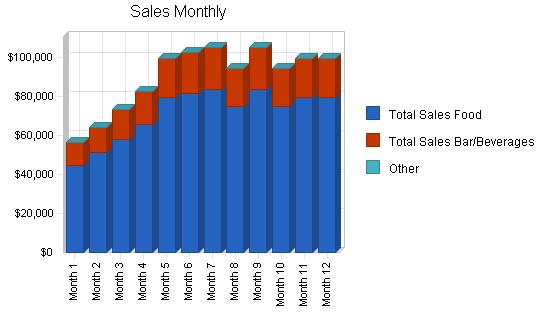


Financial Plan
Green Papaya financial model is based on a business concept to "Plan for the Worst, but Manage for the Best." We have approached the financial plan as follows: The First Year projections anticipates a below average sales volume, below average seat turn, and above average food/beverage cost. This position will help us ensure sufficient financial planning to accommodate a reasonable ramp-up period, and business success, also ensuring that we do not enter this venture under-capitalized. Financial Pro Forma In addition to the $110,000 of owner investment and $130,000 in grant monies, Green Papaya is seeking $300,000 in long-term loans and $200,000 in investment for renovations, furniture, kitchen equipment, liquor license, food & restaurant supplies, legal fees, working capital, marketing and personnel. The Financial Plan includes:6.1 Investment Opportunities The Green Papaya Investment Program allocates equity position of 20% for a total of $200,000 in investor capital. The Investment structure is as follows: Investment Opportunity
Investor Payback Program Each Investor will receive equity shares as a part owner, with a non-managerial interest in the Restaurant. Based on financial estimates, the maximum annual IRR is 12%. Over and above the interest and principal repayment, Investors contributing $100,000 or more will receive residuals for the life of the business as a bonus incentive. As with our investors, our primary goal is to earn real profits and not ‘Paper Profits'. As such we will focus on expediting returns to investors where possible. Our existing payback structure will begin paying dividend every quarter, starting in Year 2 of business operations. Investors will receive quarterly interest and annual principal reduction payments over the full term of the investment. Payback to Financial and Private Investors will take priority over any profit shares to the owners.Important Assumptions
The financial plan depends on important assumptions, most of which are reflected in the financial statements that follow. We have been cautious with our projections, and incorporate mitigation for all manageable risks. The key underlying assumptions are:
Economy
Slow Economic Recovery. We anticipate a slow-growth economy, recovering from an economic recession.
Business Growth
Annual Growth Rate Percentage: We anticipate modest growth over the coming years. The financials account for the following growth projections:
Weekly Sales Variance:
Saturday will typically be our best sales for the week. The sales volume for all other days is represented as a percentage relative to Saturday. Therefore our weekly sales will vary as follows:
Seasonal Sales Variance:
In Fort Smith, October through the late season is the most productive sales period, while the summer months tend to be the slowest restaurant period. This trend is reflected in the financials though a seasonal variance as follows (where October is targeted to be our most successful sales month):Industry & Start-Up Fiscal Year-1 Ramp-up: Our experience in the industry confirms a longer ramp-up stage for restaurants over other retail/service businesses. Our Annual Sales Growth is based on attaining the following seating capacity percentage per dining period:
Six-Month Start-Up Stage: As a new restaurant entry to the Midtown market, the ramp-up in customer draw is expected to extend over 6 months. This is reflected in a higher than average monthly sales variance shown as follows (Worst-case / Expected-case):
Market Analysis findings are static. We assume that there are no unforeseen changes in findings outlined in the Market Analysis.
Pricing & Cost Control
Competitive Pricing Model: Revenue calculations are based upon competitive price comparisons and established menu values in the current marketplace. The following are baseline assumptions on Average Check Totals, and Average Seat Turns: Daily average for lunch spending is $10.50 per person, dinner at $17.50 per person; (All check totals include Beverages). Seat Turn averages are modestly estimated at:Cost Control. Cost of goods sold have been calculated as a percentage of sales and will be monitored on a daily basis in order to keep Cost of Food within the range of 31 - 33% and Cost of Beverages (Non Alcohol) below 9%. With a focus on Cost Control, we anticipate 6 months to fine tune the restaurant operations and manage our costs within the defined tolerance range. Inventory turnover and Accounts Payable: Accounts receivable turnover is calculated to be 0 days, as payment is rendered with service. Inventory is turned on a 7 day cycle as inventory is used daily within all categories, and accounts payable are projected to be 30 days.
Risk Analysis/Mitigation
Profit and Loss Statement
The most important assumption in the Projected Profit and Loss statement is the gross margin. We show an adjustment increase in Year 2 as we exit our start-up phase of the business and move into our expected annual sales forecast. This transition shows the restaurant managing through its start-up period, and gaining efficiency and customer loyalty. In summary, the restaurant will develop its customer base and reputation and the growth will pick up more rapidly towards the second and third years of business. Month-by-month assumptions for Profit and Loss are included in the appendices.

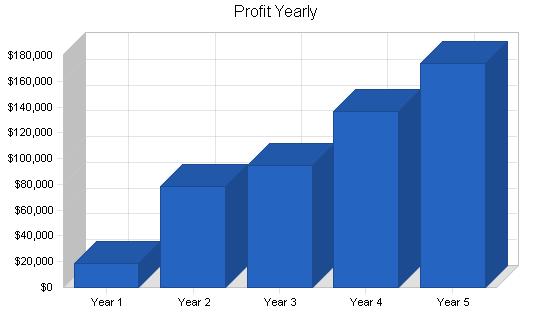
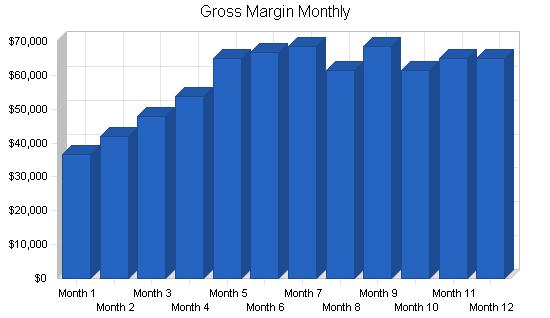

Break-even Analysis
For our First Year Break-Even Analysis, we have an average running fixed costs of $40,230 per month which includes our full payroll, rent, and utilities, and an estimation of other running costs. With direct cost of goods (inventory, in this plan) at 35% of sales, our monthly break-even point is $72,081. We will surpass our break-even point in October of our first year. As we exit the start-up phase of the business and focus on cost control, we will drive the Cost of Goods Sold (COGS) down, dropping our break-even value, and increasing our Gross Margin.
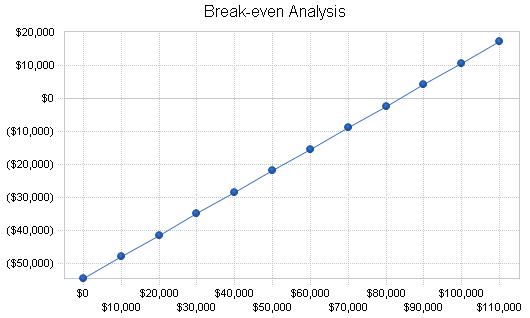
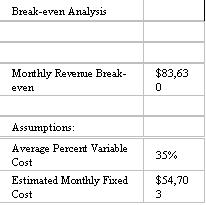
Cash Flow Statement
The cash flow depends on assumptions for inventory turnover and payment days. We have no sales on credit, so our cash flow does not track accounts receivable. Our projected same-day collection is critical, and is reasonable and customary in the restaurant industry. We do not expect to need any additional financial support, even when we reach the less profitable months, as the downturns are incorporated into the monthly revenue variance figures. Month-by-month assumptions for projected cash flow are included in the appendices.
Balance Sheet Statement
The projected Balance Sheet is quite solid. We do not anticipate difficulty meeting our debt obligations based on achieving the specific goals outlined in this plan. On a linear projection, Green Papaya has a positive Net Worth beginning in Year 3.
Expansion, Payback & Exit Strategy
In addressing this question we look at the Exit Strategy as a definition of our business vision and goals, as well as a contingency in the event the business is unsuccessful. We have addressed this question at several levels: Expansion as a Business Goal We have set multiple financial goals to grow the success of the Green Papaya concept, and compound the profit return for Green Papaya Investors.
Exit Strategy to Retire the Business We at Green Papaya are committed to our concept and its viability. We step into this venture with confidence and the success of our respective prior business efforts. No one attempts a business anticipating failure, however sometimes ventures do not fulfill their promise. In the event that our venture cannot achieve profitability and retire the encumbrances, we will first attempt to sell the operation and use the proceeds to clear all outstanding balances. If we are unable to sell the operation for sufficient proceeds we will forced to default whereby the SBA loan will be in senior standing. Any further outstanding balances will be borne by the investors on a weighted percentage basis of the total amounts due.Future Actions


